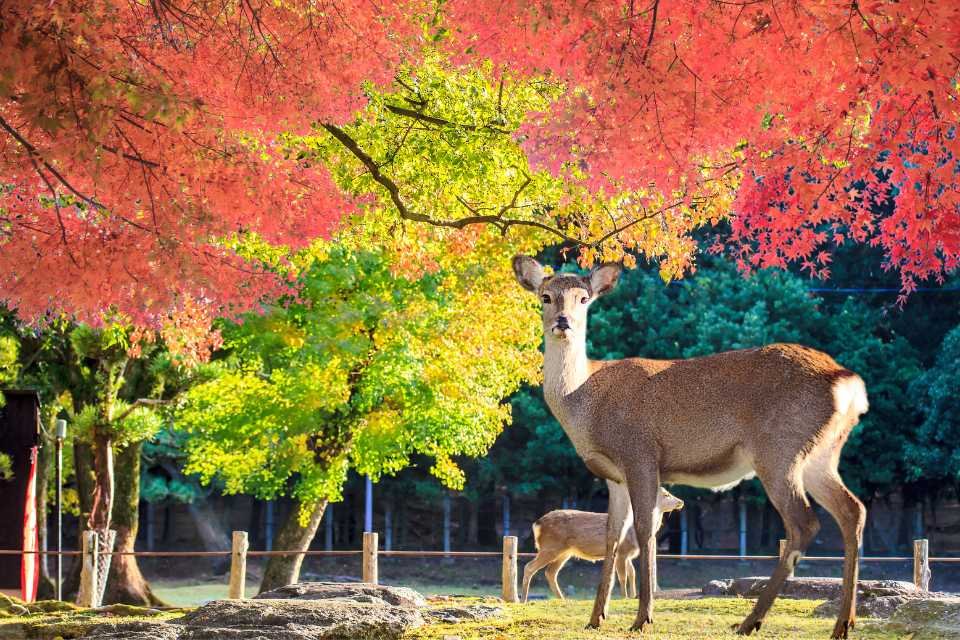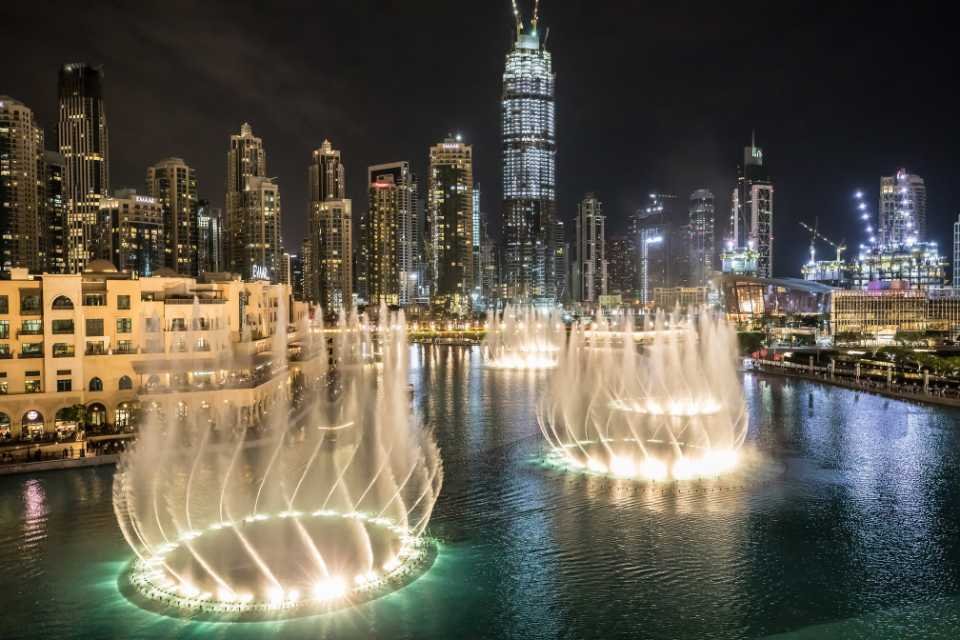10 amazing things to do in Nara, Japan
From friendly deer to incredible temples, here are our 10 best picks for Nara
The Japanese city of Nara may be small, but it’s certainly packed with great attractions like the famous Daibutsu (Great Buddha) at Todai-ji Temple, Kasuga-Taisha Shrine and Nara-koen Park, noted for its very tame, very adventurous deer.
Nara has the richest collection of traditional sites in Japan, second only to Kyoto. Nara is home to some of the country's top temples and shrines, as well as various beautiful gardens, museums and traditional communities. Here are our ten favourite things to do in Nara and some links to help you add them to your itinerary.
1 of 10
Todai-ji Temple
Japan's first permanent capital city packs centuries of history into a relatively small region. The green and beautiful city is home to some of Japan's oldest and greatest temples including the famed Todai-ji Shrine with its 15-meter-high bronze Buddha and the majestic five-story pagoda at nearby Kofukuji.
Todai-ji is a must-see on any trip to Japan. The Daibutsu-den (Hall of the Great Buddha) is the focal point of Todai-ji and it houses an epic 16-metre-high Buddha that has to be seen to be believed. Check out the Nandai-mon Gate, which is a few hundred metres east of the Daibutsu-den. Once inside, circle around the back and look for the pillar with the hole in the middle. If you can fit through it, it’s said that you will be spiritually enlightened!
See Todai-Ji on Nara guided tour, where a local licensed expert will explain the importance of the shrine and provide even more insights in English.
2 of 10
Nara National Museum
The Nara National Museum is an art museum in Nara Park that primarily displays Japanese Buddhist art. The museum, which was founded in 1889, retains its original structure and is connected to a new wing via an underground passage.
The museum's permanent collection includes Buddhist statues, paintings, scrolls and ceremonial objects. These are located in both wings. Rotating exhibitions are also held in the new wing including an annual autumn exhibition of Todaiji Temple treasures. A large portion of the collection comes from Nara's nearby temples and shrines.
The 12th century Hell Scroll, the 11th/12th century mandala Jodo mandara-zu, and the 9th century Buddha Yakushi sculpture are among the highlights on display.
3 of 10
Explore Isui-en Garden
Nara’s prettiest garden is a natural wonder in the middle of the city with a beautiful pond, carefully manicured flowerbeds and plenty of thick green trees. Isui-en is easily accessible from Todai-ji Temple and costs Y650 to enter. It’s totally worth it. Spend some time strolling in the garden and make sure you get a photo hopping across the stepping stones.
Isui-en is divided into a front garden and a rear garden, each featuring a collection of tranquil tea houses. The front garden dates back to the middle of the 17th century and is possibly older. The rear garden, which is bigger, is a little more recent, built by a rich merchant in 1899.
Entry to the garden’s museum, which features pottery and other ancient Chinese and Korean items from the family collection, is included with admission.
4 of 10
Relax in Dorogawa Onsen
Dorogawa Onsen is perfect for cleansing both your body and mind. This small rustic hot spring village is located at the foot of Mount Omine. In fact, the area is somewhat famous for its geothermal activity with numerous ryokan (traditional Japanese inns) lining the streets. Enjoy local delicacies like wild boar hotpot as part of a multi-course kaiseki dinner, then relax in the rejuvenating indoor and outdoor baths.
After you’ve spent a relaxing evening of bathing, Ryusen-ji is waiting to be explored. Watch Shugend practitioners meditate in this traditional temple before venturing into the mountains. Alternatively, you can explore the depths of Menfudo Limestone Cave on the outskirts of the city.
If you happen to be in the area in early August, you should check out the Dorogawa Gyoja Festival. This traditional event sees processions of masked dancers dressed in summer robes parading through the streets. It's part of a lively celebration of the legendary return of local legend En no Gyoja from exile.
Read next: the 18 best things to do in Japan
5 of 10
Get lost in Yoshiki-en Garden
One of Nara's best kept secrets is Yoshiki-en Garden, a small private garden that is close to the much bigger Isui-en garden.
Yoshiki-en has three distinct gardens: a pond garden, a moss garden and a tea ceremony garden. This means you can see three different types of Japanese garden all in one place. If you’re visiting in November, you’ll be lucky enough to see the stunning red of the Japanese Maple Trees as their leaves change colour.
Yoshiki-en Garden is perfect for a relaxing stroll, but the best part is, foreign visitors can enter for free!
Make your Yoshiki-en selfies even more spectacular by hiring a traditional Japanese Kimono for the day!
6 of 10
See cherry blossom from Mount Yoshino
Mount Yoshino, considered one of Japan's best hanami (cherry blossom viewing) spots, has over 30,000 sakura (cherry blossom) trees on its slopes. In Spring, the entire area is ablaze with pinks, lilacs and whites for two weeks between late March and mid-April.
Yoshino, a small town at the top of the mountain, is packed with UNESCO-registered temples, restaurants, places to stay and breathtaking views. Even if you miss the cherry blossoms, Yoshino is a scenic escape from the city at any time of year.
7 of 10
Kofuku-ji Temple
Kofuku-ji Temple is the massive temple compound that houses the towering pagoda on your right that you’ll see from Noborioji Street on your way to Nara-koen Park. The five-story pagoda is Japan's second tallest wooden pagoda at 50 metres, just seven metres shorter than the five-story pagoda at Kyoto's Toji Temple. The pagoda of Kofukuji is both a landmark and a symbol of Nara. It was originally constructed in 730 and was most recently rebuilt in 1426.
There’s an exhibition featuring documents and artefacts relating to the complex, but a stroll around the grounds of Kofuku-ji is more than sufficient if you have limited time.
8 of 10
Explore the streets of Naramachi
Nara's former merchant district, Naramachi, has several traditional residential buildings and warehouses that have been preserved and are open to the public. The district's narrow lanes are now lined with boutiques, shops, cafes, restaurants and a few museums.
Before the merchants moved in, in the 15th century, the area that is now Naramachi was almost entirely occupied by the once-vast grounds of Gangoji Temple. During the Nara Period, Gangoji was one of Japan's most important temples and it is now a Unesco World Heritage Site. Although most of the temple is now gone, there are still a few important structures to keep an eye out for.
Make sure you grab your Japan Rail Pass from JRPass.com if you want to experience Japan’s amazing bullet trains.
9 of 10
Kasuga Shrine
Kasuga Taisha is Nara's most well-known shrine. It is dedicated to the deity in charge of the city's protection and is an important shrine of the Fujiwara, Japan's most powerful family clan for the majority of the Nara and Heian Periods. Kasuga Taisha, like the Ise Shrines, had been rebuilt every 20 years for many centuries. However, in the case of Kasuga Taisha, the custom was abandoned at the end of the Edo Period, meaning the current shrine is one of the oldest and most famous in Japan.
The grounds include the Kasuga Taisha Museum, a hall close to the main complex that houses some of the shrine's relics including a pair of large ornate drums (that, sadly, can’t be played), as well as dozens of ornate traditional Japanese lamps
Take some time to look over at the Kasuga Primeval Forest, a sacred ancient forest that covers the mountain behind Kasuga Taisha.
Entry to the grounds is free, but if you want to access the ‘inner section’, it’ll cost 500 yen.
10 of 10
Feed the bowing deer in Nara-koen Park
Nara-koen is a sprawling expanse of trees and open spaces that stretches from Downtown Nara and Naramachi to the hills that rise east of the city. Nara-koen Park is not a stand-alone attraction but the easiest place to access Nara’s other noteworthy attractions, including Todai-ji Temple, Isui-en Garden, and Kasuga-Taisha Shrine.
That being said, Nara-koen Park is an integral part of any Nara visit. The beautiful landscape is dotted with ponds and lined with pleasant paths that wind in and out of trees, sculptures and traditional buildings.
However, the park's most interesting feature, especially for children, is the large population of semi-wild deer that roam the grounds. These deer are considered to be sacred and are looked after by kind volunteers who provide healthcare and the right food.
But, they really don’t need to worry about the food situation. Over time, the deer have learned to accept food from visitors and, in doing so, have picked up the habit of bowing their heads before tucking into the crackers offered to them, adding to the spirituality of the park.
You can feed them by purchasing a pack of deer crackers (shika sembei) but bear in mind the deer won’t stop at much to get their favourite snack, so keep young ones close by and don’t panic if these friendly animals gang up on you!
See the Nara deer and try a few Izakaya – tiny Japanese pubs – on a deer and beer tour!















